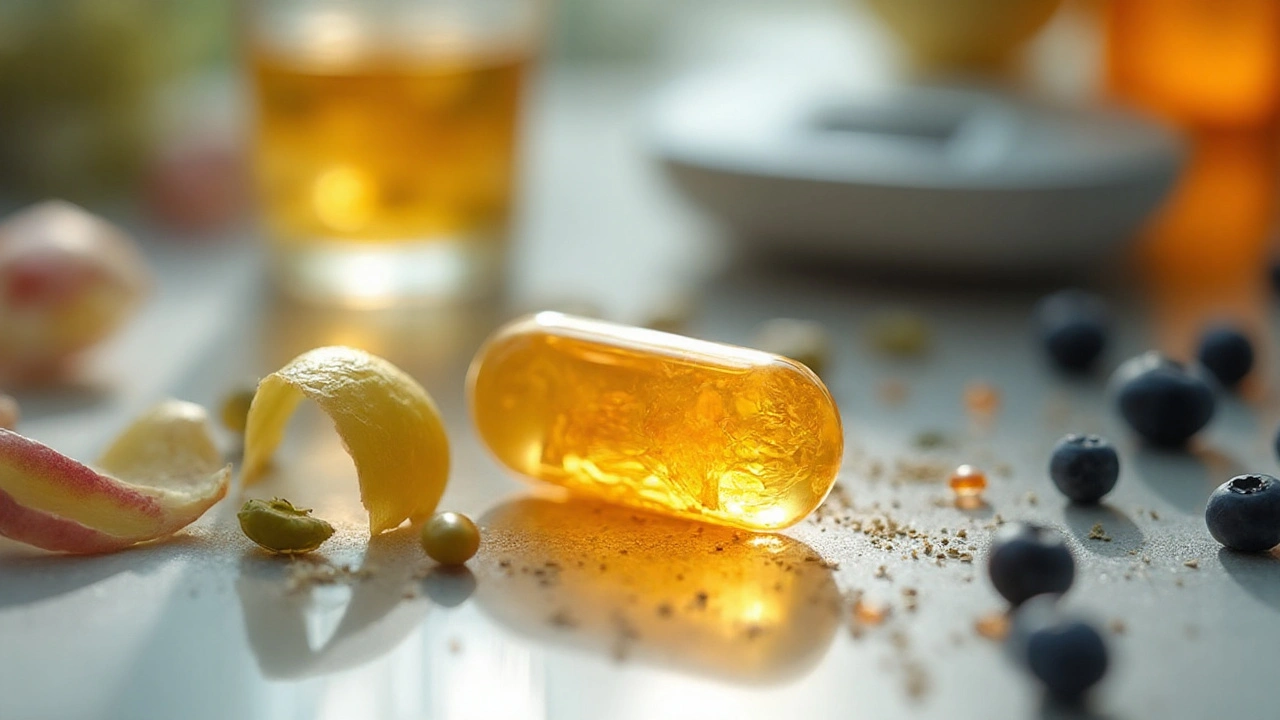Most people can name vitamin C. Few can name the plant compound hiding in onions that dozens of studies keep poking at because it seems to calm inflammation, tame allergies, and nudge blood pressure down a notch. You’ve probably eaten it for years without knowing its name. I’m talking about quercetin.
Here’s the rub: the internet labels it a “super antioxidant,” but the science is more down to earth. Some benefits show up in human trials, some don’t, and it’s not a cure for anything. If you want to try it, you should know what it can actually do, how to dose it, and where it might clash with your meds. As someone who lives in Austin and stares down cedar pollen every winter, I get the curiosity. Let’s set clear expectations and make this practical.
- TL;DR: Quercetin is a plant flavonoid found in onions, apples, and capers. It may modestly help seasonal allergies, exercise recovery, and slightly lower blood pressure in some people. It’s not a miracle.
- Dose: Common supplement range is 250-500 mg once or twice daily with food; many trials use 500-1000 mg/day for 8-12 weeks.
- Safety: Generally well-tolerated in healthy adults short term; can cause GI upset or headache. Potential drug interactions (CYP3A4/OATP/P-gp). Avoid during pregnancy/breastfeeding unless your clinician says otherwise.
- Forms: Standard quercetin dihydrate is fine; “phytosome” and enzymatically modified isoquercitrin (EMIQ) absorb better at lower doses.
- Food vs pills: You can get meaningful amounts from foods (onions, capers, buckwheat), but supplements are the only way to reach study doses.
What it is, what it does, what it doesn’t
Quercetin is a flavonoid-the colorful, bitter plant compound packed into onion skins, apples, berries, capers, kale, and even buckwheat. It acts as an antioxidant and, in lab studies, helps stabilize mast cells (the cells that release histamine). That’s why you’ll see it in “allergy support” blends, often next to vitamin C and bromelain. But petri dishes aren’t people. Here’s where the human evidence currently lands as of 2025.
Allergies and histamine symptoms. Small randomized trials suggest quercetin can reduce nasal congestion, itchy eyes, and sneezing modestly, especially when combined with vitamin C or bromelain. Human data is still limited, but the mast cell-stabilizing mechanism is plausible. If cedar season wrecks you (hello, Central Texas), quercetin may take the edge off, not replace your antihistamine. (See: clinical reviews in Nutrients, 2020-2023.)
Exercise recovery and inflammation. Several trials report less post-exercise soreness and lower inflammatory markers with quercetin, particularly at 500-1000 mg/day. Endurance performance benefits are mixed-some show small gains, many show none. If you’re training hard and want recovery support, it’s reasonable to test for a training block. (Nutrients and Sports Medicine reviews, 2019-2024.)
Blood pressure. Meta-analyses of randomized trials show small reductions in systolic pressure (about 3-5 mmHg) at doses ≥500 mg/day over 8-12 weeks, more noticeable in people with elevated BP. That’s not a substitute for meds or lifestyle, but it’s in the realm of “nice to have” for cardiometabolic stacks. (Pharmacological Research meta-analysis, 2020; updated analyses through 2023 report similar magnitude.)
Metabolic health. Results for blood sugar and lipids are inconsistent. Some studies in people with type 2 diabetes show modest improvements in fasting glucose and triglycerides; others don’t. Treat any metabolic effect as a bonus, not a guarantee. (Diabetology & Metabolic Syndrome, 2022; Clinical Nutrition ESPEN, 2023.)
Immune and antiviral buzz. Lab studies show quercetin can inhibit viral enzymes and reduce replication in cell cultures for several viruses. Human evidence is thin and low quality. Major public health bodies don’t recommend quercetin to prevent or treat viral illnesses. (NCCIH and NIH ODS fact sheets updated 2024; Cochrane respiratory infection reviews.)
Longevity/brain claims. Animal and cell data looks interesting; human outcomes just aren’t there yet. If a headline promises life extension or memory rescue, pump the brakes.
One more thing about the “super antioxidant” label. Antioxidants aren’t magic; your body’s redox system is complex. Over-supplementing with antioxidants can sometimes blunt training adaptations. Food-first still wins for long-term health foundations.
“Dietary supplements are not intended to diagnose, treat, cure, or prevent any disease.” - U.S. Food and Drug Administration
Where it lives in your kitchen. You can eat your way to decent quercetin intake if you build meals around produce. Amounts vary by variety, growing conditions, and whether you eat the skins. Here are representative numbers to anchor your expectations (rounded; lab analyses differ):
| Food | Typical serving | Approx. quercetin per serving (mg) | Notes |
|---|---|---|---|
| Capers (pickled) | 1 tbsp (8 g) | 8-15 | Among the richest sources by weight |
| Red or yellow onion, raw | 1/2 cup slices (~60 g) | 10-25 | Higher near outer layers and in red varieties |
| Apple with skin | 1 medium (~180 g) | 5-10 | Most in the peel |
| Buckwheat groats | 1 cup cooked (~170 g) | 8-12 | Good gluten-free staple |
| Kale/raw greens | 1 cup chopped (~67 g) | 3-7 | Varies widely |
| Blueberries | 1 cup (~148 g) | 2-5 | Lower than onions but still useful |
| Green or black tea | 1 cup (240 ml) | 1-3 | Depends on steep time |
To hit 250-500 mg/day from food alone, you’d have to lean heavily on capers and onions every single day. That’s why supplements exist: convenience and dose, not because food is “not enough.”

How to use it safely (doses, forms, timing, interactions)
If you decide to try quercetin, keep it simple and smart. Here’s a step-by-step plan I’ve used with readers who want structure.
- Pick your primary goal. Allergies? Training recovery? Cardiometabolic support? Your goal drives dose, form, and whether it’s worth taking.
- Screen for conflicts. If you take prescription meds-especially statins, calcium-channel blockers, transplant meds (tacrolimus/cyclosporine), antihistamines like fexofenadine, anticoagulants/antiplatelets, or you have kidney issues-talk to your clinician first. Quercetin can inhibit CYP3A4 and affect OATP/P-gp transporters, which can change drug levels. Warfarin users should be extra cautious.
- Choose a form. Standard quercetin dihydrate is fine. If you want better absorption at lower doses, look for phytosome quercetin (often labeled as a phospholipid complex) or EMIQ (enzymatically modified isoquercitrin). Small human studies report notably higher bioavailability with these forms.
- Start low, titrate. Begin with 250 mg/day with a meal for 3-4 days. If you tolerate it, increase to 500 mg/day. For short-term goals (e.g., allergy season or a training block), some people go to 500 mg twice daily.
- Take with food. Fat helps absorption; many get fewer GI symptoms when dosing with meals. Avoid taking it at the exact same time as critical meds to limit interaction risk (separate by 3-4 hours if your clinician agrees).
- Track outcomes. Give it 2-4 weeks. If there’s no meaningful change in your specific goal, stop. Supplements should earn their spot.
Dose ranges used in studies (adults):
- General wellness/antioxidant support: 250-500 mg/day.
- Allergies/histamine support: 500-1000 mg/day, often with vitamin C (e.g., 500 mg) and/or bromelain 2400 GDU/day.
- Blood pressure support: ≥500 mg/day for 8-12 weeks has shown modest reductions in meta-analyses.
- Training recovery: 500-1000 mg/day around heavy training blocks.
Forms and absorption cheat sheet. Baseline quercetin (aglycone/dihydrate) absorbs modestly. Two enhanced forms consistently show higher levels in blood:
- Phytosome (quercetin-phospholipid complex): Small human trials report up to ~10-20× higher plasma levels versus standard forms at the same dose.
- EMIQ (enzymatically modified isoquercitrin): Human data suggests ~5-10× higher absorption versus standard quercetin.
“Higher absorption” doesn’t make it stronger by magic; it just means you may need a lower dose for the same exposure. If you’re sensitive or on interacting meds, a lower-dose enhanced form can be a safer way to test.
Stacks people actually use:
- Vitamin C (250-500 mg): Often paired for allergy season. Vitamin C is safe for most and may have a small complementary effect.
- Bromelain (240-500 mg standardized): Proteolytic enzyme from pineapple; common in sinus/allergy blends. Can increase bleeding risk; skip if you’re on blood thinners unless cleared.
- Zinc (15-25 mg): Popular immune combo. Keep total daily zinc under ~40 mg unless advised; too much can tank copper status.
Safety notes you shouldn’t skip:
- Short-term tolerance: Most trials up to 1000 mg/day for 8-12 weeks report few serious issues. Common side effects: stomach upset, headache, tingling.
- Kidneys: High-dose intravenous quercetin (not typical supplements) has been linked to kidney problems in old studies. Oral doses in healthy adults look safer, but if you have kidney disease, get medical guidance before using it.
- Pregnancy/breastfeeding: Not enough safety data. Avoid unless your clinician recommends it.
- Surgery/bleeding risk: Stop 1-2 weeks before surgery; use caution if you take anticoagulants/antiplatelets.
- Drug interactions (examples, not complete): Potential to affect drugs via CYP3A4, CYP2C8/2C9, P-gp, and OATP. Be cautious with statins, calcium-channel blockers, fexofenadine, certain chemo or transplant meds, and warfarin/DOACs. Always confirm with your pharmacist or prescriber.
Timing tips: Morning with breakfast works for most. If you split doses (e.g., 500 mg twice daily), do breakfast and dinner. For training days, many take it with the largest post-session meal.
When to stop: No benefit after 4 weeks? Stop. Side effects? Stop. Starting a new prescription? Pause and ask your clinician about interactions before resuming.
What the big orgs say: The NIH Office of Dietary Supplements and the National Center for Complementary and Integrative Health (fact sheets updated through 2024) note that while quercetin shows promise for several uses, evidence in humans is limited and mixed, and no health claims are approved. That’s your reality check.

Choosing a product and making it work in real life
Not all bottles on the shelf are equal. Here’s how to pick one that matches your goal and budget without getting lost in marketing fluff.
Buyer’s checklist (5 quick filters):
- Clear dose: 250-500 mg per capsule or serving. Avoid “proprietary blends” that hide how much you get.
- Third-party testing: Look for USP, NSF, or Informed Choice logos, or a transparent Certificate of Analysis on the brand’s site.
- Form: Standard dihydrate is fine for most. Choose phytosome or EMIQ if you want lower doses with better absorption.
- Excipients/allergens: If you’re sensitive, pick simple formulas (no artificial colors, minimal fillers). Check for gluten/soy/dairy if needed.
- Price sanity check: Calculate cost per 100 mg of quercetin. Enhanced forms will cost more, but you may use a smaller dose.
Label red flags:
- Claims to “cure” or “prevent” diseases.
- No lot number or expiration date.
- Zero contact info or testing details from the brand.
Scenarios and trade‑offs:
- Seasonal allergy sufferer (Austin’s cedar season): Try 500 mg/day for 1-2 weeks before peak pollen, then 500 mg twice daily during the heavy weeks. Consider adding vitamin C. Keep your usual antihistamine on board; the combo is often better than either alone.
- Endurance athlete: If soreness crushes your training, test 500-1000 mg/day during the highest volume weeks. If you’re chasing adaptation gains, don’t mega-dose antioxidants year-round; some data suggests they can blunt training signals.
- Mildly elevated blood pressure: Discuss with your clinician. If green-lit, 500 mg/day for 8-12 weeks may shave off a few points. Track with a home monitor. Don’t use this to delay proven therapies.
- On multiple meds: Use an enhanced form at a lower dose (e.g., phytosome 100-250 mg/day), separate timing from meds by several hours, and run it by your pharmacist. If you can’t get clearance, skip it.
- Food-first person: Build meals around onions (roasted, pickled), buckwheat soba, salads with capers, apples with peel, and brewed tea. You’ll stack the benefits beyond quercetin alone-fiber, potassium, polyphenols.
Credible alternatives (depending on your goal):
- Allergy/histamine support: Vitamin C, stinging nettle, nasal saline rinses, HEPA filtration.
- Blood pressure: More potassium (produce, beans), beetroot nitrate, aerobic exercise, weight loss, limiting alcohol and sodium.
- Training recovery: Protein timing, sleep, omega‑3s, tart cherry juice, periodized training.
Mini‑FAQ:
Q: How fast does it work?
A: For allergy symptoms, some people notice a difference in 3-7 days. For blood pressure or training recovery, think in weeks (2-8) of steady use.
Q: Morning or night?
A: Take it with a meal. If you split the dose, breakfast and dinner are easy anchors.
Q: Can I take it with coffee?
A: Sure, but take it with food. If you’re on meds that interact, separate by several hours.
Q: Is food-based quercetin as good as supplements?
A: Food brings a whole orchestra of nutrients, which is great for health. To reach study doses (250-1000 mg/day), supplements are the practical route.
Q: Can I give it to kids?
A: There’s not enough high‑quality data for routine pediatric use. Ask a pediatric clinician before using it.
Q: Can I take it every day forever?
A: Use it with a purpose. Many people cycle it around seasons or training blocks. Long‑term daily use hasn’t been studied well; check in with your clinician if you plan to use it beyond a few months.
Next steps:
- If you’re curious but cautious: Eat quercetin‑rich foods for 2 weeks. Notice any allergy or congestion changes. Then decide if a short supplement trial is worth it.
- If you’re ready to test a supplement: Start at 250 mg/day with dinner for 4 days. If you tolerate it, bump to 500 mg/day. Track one outcome (e.g., sneezing episodes, RPE after hard workouts, home BP average). Reassess at 2 and 4 weeks.
- If you’re on interacting meds: Screenshot your supplement plan and ask your pharmacist: “Any issues with quercetin at 250-500 mg/day, taken 3-4 hours away from my meds?” Adjust based on their feedback.
- If you feel side effects: Stop. Re‑challenge later at a lower dose or switch to an enhanced, lower‑dose form. If symptoms persist, skip quercetin.
Why you can trust this guidance: Claims here are grounded in human trials and reviews from sources like the NIH Office of Dietary Supplements (2024 fact sheet), NCCIH, and peer‑reviewed meta‑analyses (e.g., Pharmacological Research 2020 for blood pressure; Nutrients reviews 2019-2024 for exercise and allergy data). When data is thin, I say so. When a benefit is small, I call it small. That’s the only way supplements make sense in real life.
Final thought from a guy who cooks a lot and breathes Austin air year‑round: layer your foundations first-sleep, movement, produce, stress, air filters during pollen peaks. Then, if you still want a nudge, quercetin can be a smart experiment. Keep it clean, keep it simple, and make it earn its place.






Mark Quintana
26 August 2025 - 16:26 PM
I think the dose info is solid but watch for stomach upset.
Brandon Cassidy
3 September 2025 - 07:46 AM
Having read the guide, I appreciate the balanced view on what quercetin can realistically achieve. The author rightly points out that the antioxidant hype often outpaces the human data. For allergy sufferers, the modest reduction in nasal congestion aligns with the small trials cited. When it comes to blood pressure, a 3-5 mmHg drop is clinically modest but still worth noting for people on the cusp of hypertension. Overall, the recommendation to treat quercetin as a supplemental nudge rather than a cure feels sensible.
Taylor Yokum
10 September 2025 - 23:06 PM
Quercetin is a flavonoid that lives in the skins of onions, the seeds of apples and the tiny buds of capers.
It acts like a mild firefighter, putting out the sparks of inflammation that flare up after a run or during pollen season.
The chemistry behind it is simple: it donates electrons to neutralize free radicals, and it helps keep mast cells from spilling histamine.
In the lab you can see it stop viral enzymes, but in people the effect is far more subtle and depends on how much you actually absorb.
That is why the form of the supplement matters-a standard dihydrate works, but phytosome or EMIQ can deliver several times more quercetin to your bloodstream.
Most studies that showed a benefit used doses of five hundred to a thousand milligrams per day for several weeks.
If you only take a couple hundred milligrams, you may still get a small antioxidant boost, but you probably won’t notice any dramatic changes.
For allergy relief, the data suggest a drop in sneezing and itching that is comparable to a low-dose antihistamine for some users.
For athletes, the recovery benefit appears as less muscle soreness and a modest drop in inflammatory markers, though performance gains are inconsistent.
Blood pressure studies show a reduction of three to five systolic points, which is helpful for people with pre‑hypertension but not a substitute for medication.
The safety profile is generally good, with occasional stomach upset or a mild headache in a minority of users.
People on blood thinners or certain prescription meds should check with a doctor because quercetin can tweak the enzymes that process those drugs.
When you eat foods rich in quercetin, you also get fiber, vitamins and other phytonutrients that work together in ways a single pill cannot.
A half‑cup of raw red onion can give you somewhere between ten and twenty milligrams, so you would need to eat a lot to match supplement levels.
That is why many choose the supplement route for convenience, especially during allergy season or a training block.
In practice, start low, watch how you feel, and stop if you notice any side effects-simple, sensible, and backed by the evidence we have so far.
Taryn Esses
18 September 2025 - 14:26 PM
I like the practical tone.
Albert Lopez
26 September 2025 - 05:46 AM
As a practitioner I must stress that the phrase "super antioxidant" is scientifically inaccurate; quercetin’s redox activity is modest compared to endogenous enzymes. The manuscript correctly indicates that human trials yield only marginal clinical endpoints. Moreover, the discussion on drug interactions could be expanded to include specific CYP3A4 substrates. Nonetheless, the guide provides a balanced risk‑benefit analysis appropriate for informed consumers.
Halle Redick
3 October 2025 - 21:06 PM
This is a great rundown! I’ll definitely try the phytosome version during pollen season and see how it goes.
Erica Harrington
11 October 2025 - 12:26 PM
Your step‑by‑step plan is spot on-pick a goal, start low, and track results. It gives readers a clear roadmap and keeps them from over‑doing it. Keep the momentum going!
Patricia Mombourquette
19 October 2025 - 03:46 AM
Its fine but dont overhype it
karl lewis
26 October 2025 - 18:06 PM
While the article delivers a comprehensive overview, certain nuances warrant further exploration. For instance, the differential bioavailability between dihydrate and phytosome forms could be quantified with pharmacokinetic parameters. Additionally, a deeper discourse on the interaction with statins would benefit clinicians seeking to integrate quercetin into polypharmacy regimens. The recommendation to monitor blood pressure aligns with current practice guidelines, yet the suggested duration of eight weeks may be insufficient for chronic management. Overall, the guide is commendable, albeit with room for elaboration. :)
Amy Martinez
3 November 2025 - 09:26 AM
I really appreciate how the guide balances optimism with caution; it feels like a friendly companion on the health journey.
Josh Grabenstein
11 November 2025 - 00:46 AM
Sure the supplement works but most studies are small and funded by supplement companies just trust the hype :/
Marilyn Decalo
18 November 2025 - 16:06 PM
Oh wow the hype train is in full swing and everyone’s acting like quercetin is a miracle cure when it’s really just another grain of sand in the desert of health fads!
Mary Louise Leonardo
26 November 2025 - 07:26 AM
Okay folks quercetin is the real MVP of the pantry – it’s like the secret superhero cape for onions and apples, and we’re all just missing out!
Alex Bennett
3 December 2025 - 22:46 PM
Ah yes, because nothing says ‘scientific rigour’ like a catchy supplement blog, but seriously, the advice to start low and track outcomes is solid. Keep it real and keep the experiments coming!